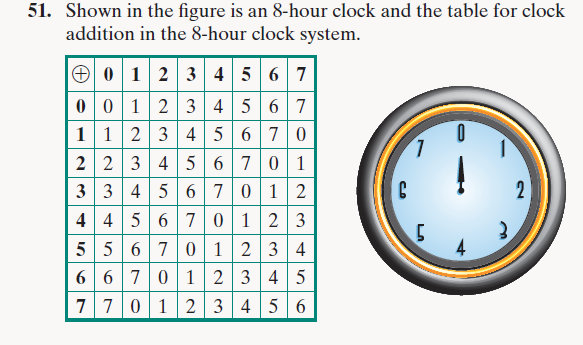
Concept explainers
Shown in the figure is an 8-hour clock and the table for clock addition in the 8-hour clock system.
|
|
0 | 1 | 2 | 3 | 4 | 5 | 6 | 7 |
| 0 | 0 | 1 | 2 | 3 | 4 | 5 | 6 | 7 |
| 1 | 1 | 2 | 3 | 4 | 5 | 6 | 7 | 0 |
| 2 | 2 | 3 | 4 | 5 | 6 | 7 | 0 | 1 |
| 3 | 3 | 4 | 5 | 6 | 7 | 0 | 1 | 2 |
| 4 | 4 | 5 | 6 | 7 | 0 | 1 | 2 | 3 |
| 5 | 5 | 6 | 7 | 0 | 1 | 2 | 3 | 4 |
| 6 | 6 | 7 | 0 | 1 | 2 | 3 | 4 | 5 |
| 7 | 7 | 0 | 1 | 2 | 3 | 4 | 5 | 6 |

a. How can you tell that the set {0, 1, 2, 3, 4, 5, 6, 7} is closed under the operation of clock addition?
b. Verify the associative property:
c. What is the identity element in the 8-hour clock system?
d. Find the inverse of each element in the 8-hour clock system.
e. Verify two cases of the commutative property:
Want to see the full answer?
Check out a sample textbook solution
Chapter 5 Solutions
Thinking Mathematically (7th Edition)
- For each of the time series, construct a line chart of the data and identify the characteristics of the time series (that is, random, stationary, trend, seasonal, or cyclical). Date IBM9/7/2010 $125.959/8/2010 $126.089/9/2010 $126.369/10/2010 $127.999/13/2010 $129.619/14/2010 $128.859/15/2010 $129.439/16/2010 $129.679/17/2010 $130.199/20/2010 $131.79 a. Construct a line chart of the closing stock prices data. Choose the correct chart below.arrow_forward1) Express these large and small numbers from the Read and Study section in scientific notation: (a) 239,000 miles (b) 3,800,000,000,000 sheets of paper (c) 0.0000000000000000000000167 grams 2) Find all values for the variable x that make these equations true. (a) 5x = 1 (b) 3x = 1/1 9 (c) 4* = 11/ 4 (e) 4* = 64 (g) 10x = 1,000,000 (d) 3x=-3 (f) 2x = = 8 (h) 10x = 0.001arrow_forward(b) 4) Find an equation to fit each of the following graphs: (a) 20 20 18 16 14 12 10 8 6 4 2 24 22 20 18 16 14 12 10 8 16 A 2 -3 -2 -1-0 2 3 4. -1 0 1 2 3. -2 -2arrow_forward
- 3) Which of the following are equivalent to 3? (There may be more than one that is equivalent!) -1 (a) (9)¯¹ 3. (b) (-3)-1 (c) (-3) -1 (d) -(¯3) (e) 11 3-1 (f) 3-4arrow_forwardY- ___b=_____ (X- )arrow_forwardFor each of the time series, construct a line chart of the data and identify the characteristics of the time series (that is, random, stationary, trend, seasonal, or cyclical) Date IBM9/7/2010 $125.959/8/2010 $126.089/9/2010 $126.369/10/2010 $127.999/13/2010 $129.619/14/2010 $128.859/15/2010 $129.439/16/2010 $129.679/17/2010 $130.199/20/2010 $131.79arrow_forward
- 5) State any theorems that you use in determining your solution. a) Suppose you are given a model with two explanatory variables such that: Yi = a +ẞ1x1 + ẞ2x2i + Ui, i = 1, 2, ... n Using partial differentiation derive expressions for the intercept and slope coefficients for the model above. [25 marks] b) A production function is specified as: Yi = α + B₁x1i + ẞ2x2i + Ui, i = 1, 2, ... n, u₁~N(0,σ²) where: y = log(output), x₁ = log(labor input), x2 = log(capital input) The results are as follows: x₁ = 10, x2 = 5, ỹ = 12, S11 = 12, S12= 8, S22 = 12, S₁y = 10, = 8, Syy = 10, S2y n = 23 (individual firms) i) Compute values for the intercept, the slope coefficients and σ². [20 marks] ii) Show that SE (B₁) = 0.102. [15 marks] iii) Test the hypotheses: ẞ1 = 1 and B2 = 0, separately at the 5% significance level. You may take without calculation that SE (a) = 0.78 and SE (B2) = 0.102 [20 marks] iv) Find a 95% confidence interval for the estimate ẞ2. [20 marks]arrow_forwardPage < 2 of 2 - ZOOM + The set of all 3 x 3 upper triangular matrices 6) Determine whether each of the following sets, together with the standard operations, is a vector space. If it is, then simply write 'Vector space'. You do not have to prove all ten vector space axioms. If it is not, then identify one of the ten vector space axioms with its number in the attached sheet that fails and also show that how it fails. a) The set of all polynomials of degree four or less. b) The set of all 2 x 2 singular matrices. c) The set {(x, y) : x ≥ 0, y is a real number}. d) C[0,1], the set of all continuous functions defined on the interval [0,1]. 7) Given u = (-2,1,1) and v = (4,2,0) are two vectors in R³-space. Find u xv and show that it is orthogonal to both u and v. 8) a) Find the equation of the least squares regression line for the data points below. (-2,0), (0,2), (2,2) b) Graph the points and the line that you found from a) on the same Cartesian coordinate plane.arrow_forward1. A consumer group claims that the mean annual consumption of cheddar cheese by a person in the United States is at most 10.3 pounds. A random sample of 100 people in the United States has a mean annual cheddar cheese consumption of 9.9 pounds. Assume the population standard deviation is 2.1 pounds. At a = 0.05, can you reject the claim? (Adapted from U.S. Department of Agriculture) State the hypotheses: Calculate the test statistic: Calculate the P-value: Conclusion (reject or fail to reject Ho): 2. The CEO of a manufacturing facility claims that the mean workday of the company's assembly line employees is less than 8.5 hours. A random sample of 25 of the company's assembly line employees has a mean workday of 8.2 hours. Assume the population standard deviation is 0.5 hour and the population is normally distributed. At a = 0.01, test the CEO's claim. State the hypotheses: Calculate the test statistic: Calculate the P-value: Conclusion (reject or fail to reject Ho): Statisticsarrow_forward
- Page < 1 of 2 - ZOOM + 1) a) Find a matrix P such that PT AP orthogonally diagonalizes the following matrix A. = [{² 1] A = b) Verify that PT AP gives the correct diagonal form. 2 01 -2 3 2) Given the following matrices A = -1 0 1] an and B = 0 1 -3 2 find the following matrices: a) (AB) b) (BA)T 3) Find the inverse of the following matrix A using Gauss-Jordan elimination or adjoint of the matrix and check the correctness of your answer (Hint: AA¯¹ = I). [1 1 1 A = 3 5 4 L3 6 5 4) Solve the following system of linear equations using any one of Cramer's Rule, Gaussian Elimination, Gauss-Jordan Elimination or Inverse Matrix methods and check the correctness of your answer. 4x-y-z=1 2x + 2y + 3z = 10 5x-2y-2z = -1 5) a) Describe the zero vector and the additive inverse of a vector in the vector space, M3,3. b) Determine if the following set S is a subspace of M3,3 with the standard operations. Show all appropriate supporting work.arrow_forwardFind the Laplace Transform of the function to express it in frequency domain form.arrow_forwardPlease draw a graph that represents the system of equations f(x) = x2 + 2x + 2 and g(x) = –x2 + 2x + 4?arrow_forward
- Algebra & Trigonometry with Analytic GeometryAlgebraISBN:9781133382119Author:SwokowskiPublisher:Cengage
